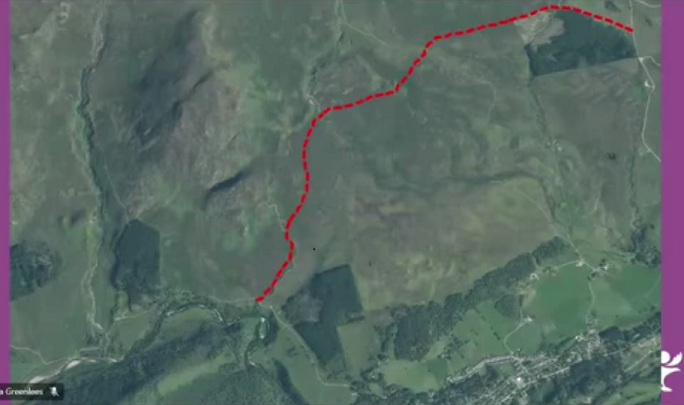
Last Friday the Cairngorms National Park Authority (CNPA) Board rejected the planning application to construct a new road round Newtonmore that would have connected the Pitmain and Glen Banchor estates (see here). The video of the meeting is still on the internet, which is contrary to the usual practice of the CNPA but is a very welcome step towards greater transparency in how decisions are made . Other people seem to think so too because five days later it has had 73 views, far more people than would normally observe planning meetings.
The presentations and discussions on the Pitmain – Glen Banchor road – from 48 mins into the meetinng – were very instructive for anyone who wishes to understand the interaction between sporting estates and the planning system. This post summarises and comments on what was said from the various perspectives.
The arguments of the applicants, the Pitmain Estate
The presentation started with Ewan Harris claiming that “excellent environmental stewardship can exist alongside traditional sporting management” and that the estate is “trying to do really good things”. To support this he referred to the riparian planting along the River Calder in Glen Banchor which he claimed, “we have already done”. In fact the signs about the project state it was funded by NatureScot and the Woodland Trust rather than the very rich owners, the Jafar family (see here).
Mr Harris stated the purpose of the road was to “remove non-native windblown exotic species” and asserted it was therefore “integral to conservation in Glen Banchor”. This was not clearly explained in the planning documents and I had assumed the windblown trees – 42 out of 67.5 hectares not all of which are non-native – would be left in place as they are valueless as timber. If the estate is proposing to remove the windblow this begs the questions what do they intend to do with it (bio-mass fuel?) and, as importantly, whether from a climate change and conservation perspective this makes any sense.
The confusion around Pitmain’s intentions increased when, in response to a question from John Kirk, Ewan Harris stated the area of non-native timber was c.80 hectares, a figure that did not fit with the figure of 67.5 ha that had been supplied to the CNPA. Fraser Gillespie, the surveyor who had worked on the application, then said this amounted to about 50,000 tonnes, which would go to a “variety of timber processors” in the Highlands. That implied the windblow would be processed. None of that adds up but what neither Mr Harris nor Mr Gillespie explained was, whatever the type and quantity of timber involved, why couldn’t it just be extracted down the public road?
Fraser Gillespie went on the offensive in his part of the presentation claiming that “every one of the Planning Officer’s statements can be dismantled” (they had recommended the application be rejected) – a huge claim – but chose to focus on just two. The first was officers’ statement that the “track had not been designed to reduce the impact on the natural environment”. This was based on the number of cuttings, embankments and the way the road crossed deep peat. Mr Gillespie considered this wrong, claiming the applicant had considered a number of routes and provided information to the CNPA about that. The CNPA checked their records before clarifying that they had only ever received information on two routes, the first in the application that was withdrawn and the one being considered at the meeting. Whatever the details, this nitpicking missed the point: creating 4.83km of new road over moorland cannot help but have huge environmental impacts.
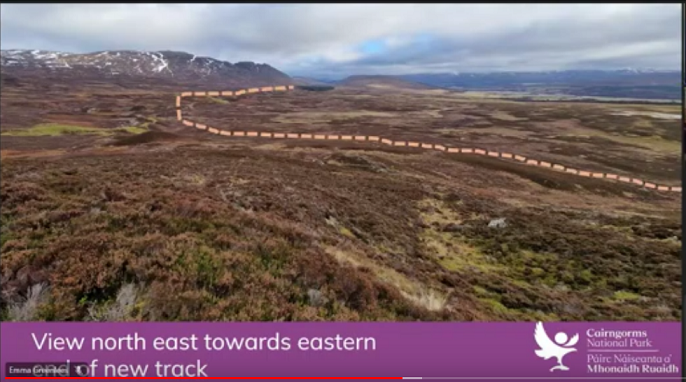
Mr Gillespie’s second claim was that the CNPA officers’ evaluation of the impact the road would have on peat was totally wrong. He referred to recent research from Wales, without citing the reference, which he claimed showed the top 0.5m of peaty soils stores zero carbon. If true, that would be truly staggering, with carbon being the key component to all organic material in soils, including peat. One suspects that Mr Gillespie may have been misinformed.
Mr Gillespie went on to argue that the “environmental benefits of forestry conservation outweigh the impacts of the track”. To support this he introduced a map of forestry proposals the estate was discussing with Scottish Forestry (which had not been submitted with the application):
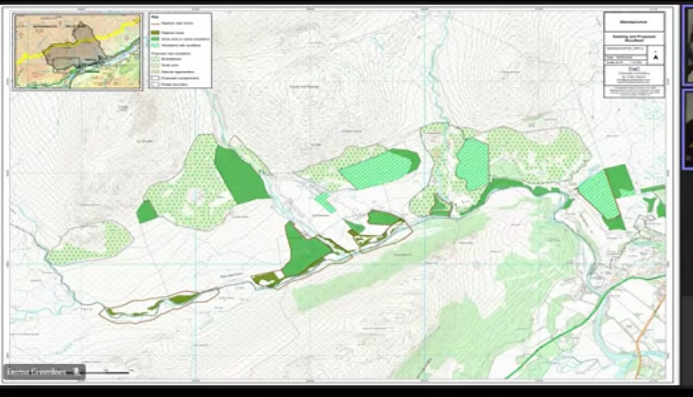
This native woodland planting proposal was not shown on the map submitted with the application:

CNPA officers rightly stated all of this new information was irrelevant to the planning application which was for a road. As for the applicant’s suggestion that the new road might also make it easier to bring in fencing materials in the future, large lorries are definitely not required to do this.
The key point here is that whatever the merits of the plans Pitmain is apparently discussing with Scottish Forestry – and I believe they are highly questionable – it should be obvious from a National Park perspective that any conservation benefits would be worth for more if any extraction and planting of trees did not require or involve the construction of a damaging new road
Mr Gillespie introduced one other new proposal at the meeting. He said Pitmain would take out the first 60m of sheep dog trial track, an ATV route which they had in 2017 turned into a road without planning permission (see here), to help rationalise the estate road network and compensate for the 4.83 km of new road.
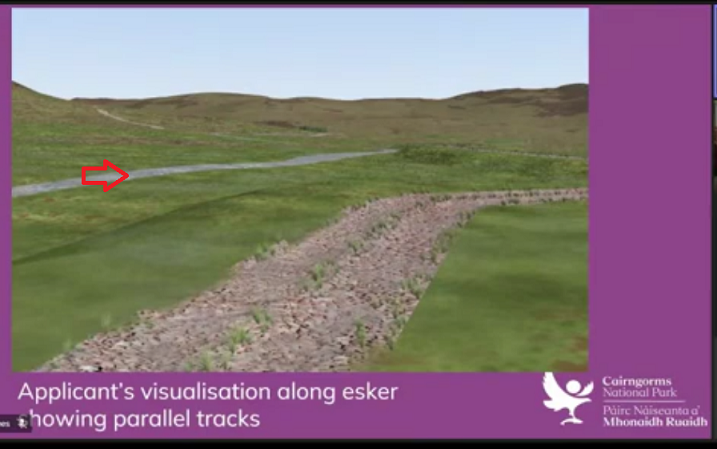
By my reckoning the new road would be 80 times the length of the section of road Pitmain has now offered to remove!
The consideration of the application by CNPA officers
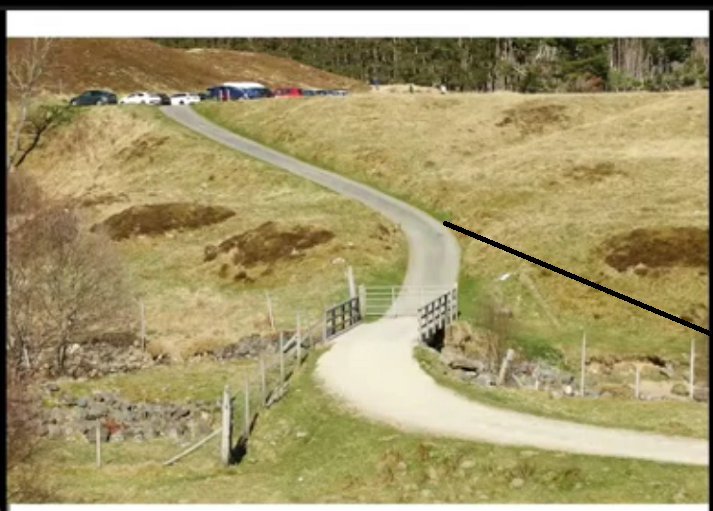
It is difficult to see how straightening the road here and adding a new bridge here could be done without detriment to its landscape quality whereas, if small vehicles were used, none of that would be necessary. Moreover, other elements of the proposals to the west of the new bridge weren’t considered in the presentation. In my view therefore the reasons for rejecting this application were even stronger than those presented in the report and to the Board.
The presentation by objectors to the application
Three objectors, the North East Mountain Trust, Badenoch and Strathspey Conservation Group and Dave Morris had asked to address the meeting and shared a ten minute slot (from 1hour 26 mins). By contrast to the presentation from CNPA officers, which introduced elements of ambiguity into the discussion, the objectors were very clear. NEMT emphasised the new section of road was contrary to the CNPA policy presumption against new roads over open moorland; BSCG focused on its wider environmental and landscape impacts; and Dave Morris explained why it was not necessary for forestry or conservation purposes and appeared intended for sporting use.
The CNPA Board’s response
If their staff had found the application “difficult”, members of the CNPA Board appeared in no doubt.
Fiona McLean responded very strongly to the applicants presentation, challenging what she described as their attempt to call into question the integrity of the National Park officers, which she distinguished from the right of applicants to disagree with what they had said.
Doug Macadam, former Director of Scottish Land and Estates, said in this case he was “afraid” he could not support the application while asserting his support for sporting estates in general. That spokes volumes about just how bad this proposal was.
Most importantly, Eleanor Macintosh, the former Convener of the Planning Committee, emphasised the CNPA policy presumption against new hill tracks over moorland and the background to this, including the lengthy discussions among the Board and the years it had taken them to agree their position. It seems that other Board Members agreed as the decision was unanimous and made in less than five minutes.
Implications of the decision and discussion
Given their statutory duties to conserve the landscape and natural environment and the policy presumption they have adopted against new hill tracks on open moorland, if the CNPA had done anything other than refuse this planning application they would undermined the very purpose of National Parks. That was probably never on the cards. What was said by Board Members, however, was still very welcome and gives a very strong message to landowners and to staff.
That the Pitmain Estate thought they had a chance, says something about the attitudes of private landowners accustomed to get their way, as does their approach to the application which raised more questions than it answered. As for CNPA staff, perhaps in future they will be more confident about applying the policy presumption against new tracks and learn to say no at an early stage, rather than extending proceedings in an apparent effort to be seen to be acting fairly?
The wider issue that arises from the new “conservation” plans that Pitmain introduced at the meeting is their vision of what the future of upper Glenbanchor should be: yet more blocks of new woodland surrounded by deer fences all funded by the public through Scottish Forestry grants.
The fundamental problem that is not being addressed is that there are far too many deer on the Pitmain and Glen Banchor estates and if these were reduced down to appropriate levels there would be a massive expansion of native trees and shrubs, as evident on Creag Dubh on the south side of the River Calder. The recent riparian planting, with its great long lengths of deer fencing and massive gates, was an absurd waste of public money. Shooting the deer and stopping muirburn is the obvious way forward and the CNPA needs to pursue that strategy if conservation is to become a reality.

2 Comments on “The CNPA rightly rejects the Pitmain – Glen Banchor link road planning application”